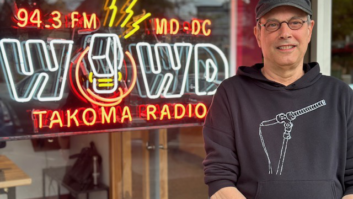After I retired from my position as chief engineer for KFI(AM) and KOST(FM) in Los Angeles, my wife Herta and I were fortunate to be able to take cruises in various parts of the world, and ski trips to Utah from 2003 to 2006, all while I continued my part-time job — taking care of KBLA(AM) — and did occasional remote broadcasts for various stations. Retirement continued to be good.
Boredom has not been a problem. I think I was bored once for about 10 minutes until I remembered the next household or ham radio (W6OQI) project I wanted to do. Usually I find the days come to an end and I have not done all that I wanted to do that day.
But life is not always a bowl of cherries.
A different kind of PSA
On Jan. 24, 2007 we made the final payment on a cruise to Australia, Tasmania, New Zealand, Fiji, American Samoa and Tahiti. On Jan. 26, I had my annual blood test, which includes a PSA test (Prostate Specific Antigen), which I assumed would be normal as in previous years.
On Jan. 30 I received a call from our family doctor saying I may have a problem because my PSA was 4.55, up from 3.29 the year before. Generally you do not want to see a PSA above 4.0. This was too much of an increase for one year. The doctor did not say I have prostate cancer but it was time to see the urologist for a prostate biopsy.
I have to say it was a time of anxiety waiting for the results of the biopsy. Two days later the bad news was that the biopsy showed early-stage prostate cancer. This certainly was not the information I wanted, though I was not too surprised because my father had died of what started as prostate cancer but was not diagnosed early enough.
During a lengthy discussion with the urologist about the treatment options, I could see I had a lot of research to do in order to decide which treatment option to pursue.
The first option mentioned was surgical removal of the prostate gland. I did not care for this. I then studied various forms of radiation therapy. One interesting option is brachytherapy, the placement of radioactive seeds into the prostate gland to kill the cancer.
Another form of brachytherapy is the insertion of hollow tubes into the prostate gland through which radioactive material is placed for a limited time as controlled by a computer. Brachytherapy is often accompanied by a period of a few weeks of external radiation.
(click thumbnail)Collins prepares for his final treatment session, 38 of 38.Gray area
While researching all of this, I came across www.tomotherapy.com and was impressed with this new system for non-invasive treatment of many forms of cancer, including prostate cancer.
TomoTherapy offers accurate precision-aimed radiation of the tumor with minimal radiation of the surrounding tissue. After revisiting the site and reading more about the treatment, I felt this was the treatment for me.
The TomoTherapy Web site contains a list of hospitals offering the treatment. I found the City of Hope National Medical Center in Duarte, Calif., to be the closest to my residence. I called and made arrangements for a consultation with one of its doctors, Dr. Jeffrey Wong. After consulting with Dr. Wong for about an hour we agreed that TomoTherapy would be an appropriate treatment for my prostate cancer.
Dr. Wong explained that, empirically, it has been determined that 76 units of radiation — known as Grays — are needed to kill prostate cancer. One Gray dose is equivalent to one joule radiation energy absorbed per kilogram of organ or tissue weight. In my case, the radiation via TomoTherapy is delivered at the rate of 2 Grays per day for 38 days to make the required 76 Grays.
So far, side effects have been minimal and I am delighted with TomoTherapy. Of course it will take some time after treatment to determine if the TomoTherapy was successful. Dr. Wong believes the 38 days of treatments will be all I require. Time will tell.
You may wonder why I have been telling you about all of this. There is a moral to this story. If you are 50 years of age or older, be certain to have your annual PSA blood test. Prostate cancer is very common in men over 50 and it is important to catch it early, as I did.
I would like to give a thank you to the staff at City of Hope for their kind and courteous treatment; and a special thank you to Carmen Grau, the radiation therapist who greets me every day at TomoTherapy machine Number One. As I write, today is treatment number 38 of 38. This is the end of my daily trips to City of Hope for the past eight weeks.
A follow-up visit will take place in a month. After that I will return to City of Hope every four months for PSA testing to be certain the prostate cancer has been eliminated.
For more detailed information, visit www.tomotherapy.com.













